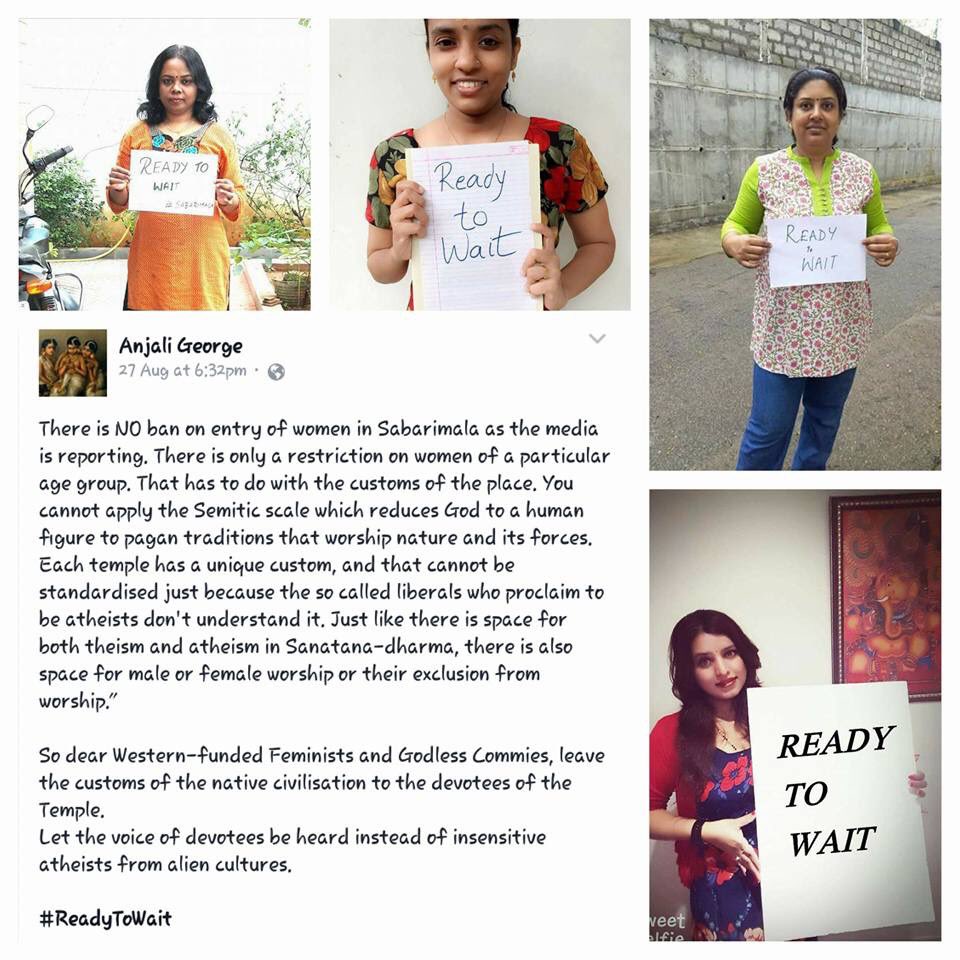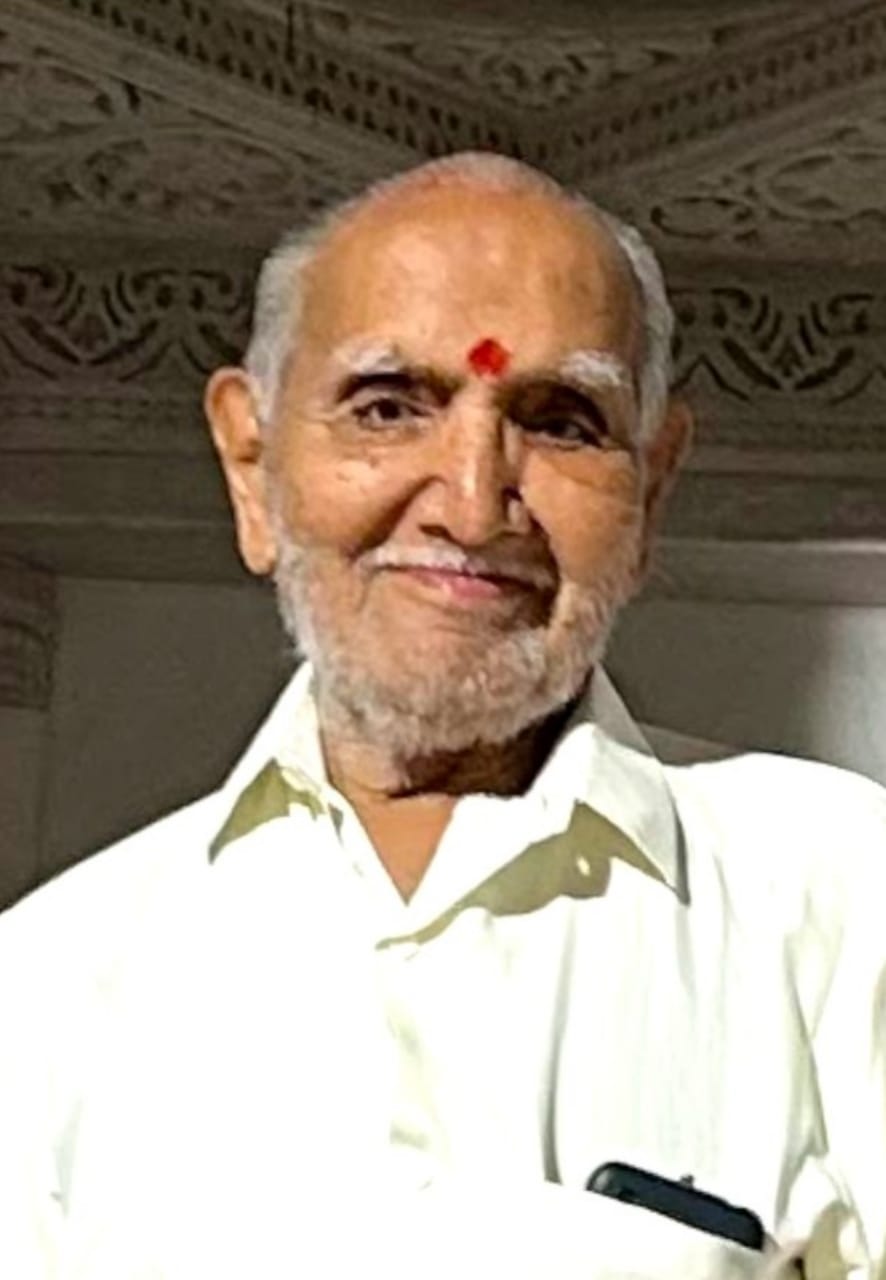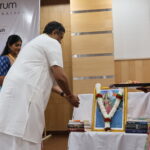
Here is an interview of Social Activist Anjali George with ‘India Facts’ website.
#ReadyToWait: A campaign to reclaim Hindu temples and traditions.
A group of women devotees from Kerala have started a new campaign #ReadyToWait, asserting how devotees of the Sabarimala temple understand and respect the temple traditions regarding women’s entry.

The issue of restrictions on the entry of women into some places of worship has been a matter of debate for the few years. Since, last year, Sabarimala Ayyappa Swami Temple in Kerala, which prohibits entry of women during their reproductive age has been the main focus of such debates.
In the aftermath of the Bombay High Court’s verdict allowing women to enter the sanctum sanctorum of Haji Ali dargah in Mumbai, similar demands were again raised regarding the Sabarimala temple.
In response to these demands by certain feminists and women’s rights activists, a group of women devotees from Kerala have started a new campaign #ReadyToWait, asserting how devotees of the Sabarimala temple understand and respect the temple traditions regarding women’s entry and how they do not want those traditions to be discarded. They are asserting that women devotees of Kerala are ready to wait till they are 50 to enter the Sabarimala temple and the demands by non-devotees to discard the tradition in the name of gender equality amounts to infringement on religious freedom.
IndiaFacts spoke to Anjali George, who is an Independent Researcher from Kerala, currently residing in Germany, and who, along with her group of women devotees are spearheading this campaign on Social Media.
IndiaFacts: The Sabarimala entry issue is quite old and is making headlines, since last year. What made you start this #ReadyToWait campaign now? What is the central message of the campaign? Who are all involved in this campaign?
Anjali George: What you said is right. It’s not long since the Sabarimala issue has been making headlines. Things were cool there till a section of politically minded feminists, who have nothing to do with faith decided that something was wrong. They have absolutely no clue of the scientific and philosophical basis of a temple and falsely and foolishly equate the practices of Santana Dharma with the inborn discrimination in Semitic religions. The faithful mostly tend to ignore them and look after their own business. But, this emboldened these activists into believing that they represent women; that ONLY THEY represent women.
These were some random thoughts, which many of us had when we saw these high-decibel feminists shouting in TV studios as if they represented the entire community of women. They undoubtedly are organized and enjoy political patronage. This helps them get more air time on TV and space in print. But, we had to tell these misguided souls that we know to take care of our business and didn’t need their ‘helping’ hand. The media or authorities never cared for our views. But, we were determined to make ourselves heard. That’s how we decided to take to social media with a hashtag. #ReadyToWait is to tell the so called activists that they are wrong on Sabarimala; to tell all the decision makers that we devotees are the more important stakeholders in the debate over faith and not the atheist feminists. A handful of activists, who do not have the temerity or the maturity to understand the underpinnings and beauty of Indian spirituality are not the ones who should decide about how half a billion women in India should follow their faith. Why should those who have only contempt for our beliefs tell us how we should conduct ourselves in matters of faith?
This campaign is a team effort, but people like Padma Pillai, Suja Pavithran, Radhika Menon, Shilpa Nair, Krishnapriya, Manju Panicker, etc. were among the first who declared that we are ready to wait for our turn to have darshan of Ayyappa Swami in Sabarimala. I’m glad that I could also be a part of this noble initiative.
IndiaFacts: Can you shed some light on why the temple tradition at Sabarimala prohibits entry of women between ages 10 and 50, while no such prohibition exist in many other temples dedicated to Lord Ayyappan?
Anjali George: Deities in most temples are represented using complex, cryptic epithets (paroksha priyaahi iva devah). The tradition in Sabarimala is based purely on the concept (Devata-Sankalpa) thatShasta (Lord Ayyappa) of Sabarimala is in the form of a `Kumara’ (teenager) observing Brahmacharya(Celibacy, Detachment and Dispassion). The point to be noted here is that Sabarimala Ayyappa is different from other Ayyappa temples. To understand this better, we need to look at some of the other associated Shasta temples in the region. Sabarimala is the most prominent of these and Ayyappa is worshipped there as Dharma Shasta (teacher of Dharma). But what is interesting is that the deity is the same in three other temples as well – in Kulathupuzha, Aryankavu, and Achankovil. However, in these three temples, Ayyappa is in three different forms namely Bala (child) in Kulathupuzha, Bharyasametha (with wife) in Achankovil and Tapasa (ascetic) in Aryankavu. The four shrines are related to each other, but in only one of them is Ayyappa a Naishtika Brahmachari (one who strictly and always practices complete dispassion). These four `pratishtas’ (installations) denote the four stages of human life – `Balaka’(childhood), `Kumara’ (youthful years when one is expected to practice brahmacharya), `Bharyasametha’ (here, the Lord sits with wives and enjoys worldly life) and Tapasa (old age – where a man leaves for vanaprastha). These four shrines have to be observed collectively to get the complete picture on Ayyappa. What many overlook is that, except in Sabarimala, where Ayyappa is in his `Brahmachari’ phase, there is no restriction on entry of women in the other three temples or in any other Ayyappa temple around the globe.
The reason behind the restriction on the entry of women of a particular age group into the Sabarimala temple is simple. Pilgrims to Sabarimala are expected to observe strict `Vrata’ (penance) of 41 days. It is called ‘Mandala Vrata’. For a woman, this may not be possible as her menstrual cycle, which is often a tiresome and painful experience repeats every month and it does not allow one to maintain the required ritual “Shaucha” for all 41 days, which is central to the Vrata. Since, Ayyappa at Sabarimala is a Naishtika Brahmachari, the energy in the temple may create an imbalance in the natural creative energy present in women of reproductive age, if they are repeatedly exposed to those energies over long period. This may in turn prevent Grihasta women from effectively doing their Swadharma. Hence, only those who are yet to attain puberty or those who have already reached menopause undertake the pilgrimage.
IndiaFacts: Feminists have often pointed out how prohibiting the entry of women of menstruating age into Sabarimala amounts to misogyny and discrimination against women and hence infringes on the women’s right to pray. What is your take on this?
Anjali George: It is ignorance, which makes them see the practice in Sabarimala as discriminatory. Practicing Hindu women generally keep away from the places of worship, whether at home or outside, when they are having their monthly periods. There are many reasons attributed to this. From what I understand, menstruation is not an impure act per se, but the aftermath of a powerful process, wherein a woman readies herself to procreate, to give life to a child. The energy associated with this act is believed to be so huge that it can interfere with and even eclipse the energy present in a temple. It also brings about severe physiological and emotional changes in a woman necessitating care for the days it lasts. Such is the beauty of Sanatana Dharma that some temples even celebrate the menstrual phase of women. For example, in the famed Kamakhya temple in Assam and the Devi temple in Kerala’s Chenganoor, it is the Devi’s `yoni’ (Vagina) and menstruation, respectively that are celebrated. If the beliefs of Hindus were as brittle as some ‘ignoramus’ are trying to portray, thousands of devotees would not have been eager to receive the Goddess’ menses blood as Prasad in these temples. This alone is enough to expose the hollowness of the claim that Sanatana Dharma discriminates menstruating women, while the truth is that it worships them during the biological phase.
The problem is we never made any attempt to study all this wisdom, which our forefathers left behind for us. Instead, we allowed ourselves to be hijacked by man-made faiths, which basically saw humans as products of sin. Our education system is basically fashioned on a Western model and those who pass through it unconsciously tend to compare indigenous Dharmic traditions with Abrahamic organized religions. They don’t realize that it is suicidal and illogical to apply the Semitic scale that reduces God to a mere human figure to pagan traditions that worship nature and its forces as manifestations of divinity. These activists are denying humanity the fruits of a way of life, which offers room for spiritual inquiry and instead are `forcing’ practitioners of Dharmic traditions to embrace short-sighted traditions that have sought to spread their faith by the power of swords and guns.
Each temple has a unique custom and practices rooted in Tantra Shastras and tailor-made for the kind of deity invoked in those temples. These temple traditions cannot be standardized just because the so called liberals, who ridicule faith cannot understand their context and meaning. It will do well for all, if these activist sisters take some time off to study the scientific foundations of Sanatana Dharma before jumping to half-baked conclusions. But, of course, trying out Google would not be enough and they might have to undertake a serious spiritual quest to arrive at the right answers.
IndiaFacts: In one of your tweets, you take serious exception to feminists and activists fighting for #RightToPray and state that devotees don’t need atheist spokespersons to empower them. Can you elaborate on this?
Anjali George: During the British rule, when Temple entry agitation had started in Kerala, many non-Hindus, Christian missionaries and atheists had approached Mahatma Gandhi offering their support for the struggle. But, he rightly rejected their offer. According to him, the sanctity of the temple and the deity were important for only those who believed in the Hindu tradition. Gandhi ji’s action prompts me to ask these feminists, who are they to speak for the devotees on a subject they abhor?
By appointing themselves as the champions of the rights of women devotees, what the feminists actually imply is that these devotees are incapable of fighting for themselves. That’s one kind of classism too. It is a modern version of the ‘White Man’s Burden’ to civilize unwashed pagans. Hindu civilization always had valued the opinion of women and we had women warriors fighting shoulder to shoulder with men in history. So, if practicing Hindu women need to fight for any ‘rights’, we can fight on our own.
IndiaFacts: Some equate the restriction on the entry of women in Sabarimala to social evils like sati, child marriage, etc. What is your take?
Anjali George: That is a false equation. Sati, child marriage, prohibition on widow remarriage, etc., were social customs, which transformed into social evils in the course of time due to changed situations, wherein certain Shastric guidelines were no-longer applicable combined with distortion and misuse of such guidelines. Since, the social condition has changed even more today, there can be no equation of practices like Sati with temple traditions. Moreover, Sati etc. is completely unconnected with temple as they are not ritualistic practices affecting the temple deity and worship. The manner in which a deity is to be worshipped is something that is exclusively prescribed for each deity based on its Nama (name), Roopa (form), and Svaroopa (essence).
IndiaFacts: Some people have drawn a comparison between the prohibition on the entry of women in Mumbai’s Haji Ali and the prohibition in Sabarimala. What is your take on it? Is there any parallel between them?
Anjali George: That’s exactly the sinister plot – to paint Sanatana Dharma and Semitic religions with the same brush and confuse people into thinking what the heck, if I choose x or y, all are same.
To understand this debate, it is necessary to delve a little into the politics involved. It is difficult to uproot a living tree, but a dry one will fall by itself. Sanatana Dharma is a mighty tree whose roots run deep and under whose green canopy many civilizations have thrived. It is a way of life, which has crystallized over thousands of years through a system of checks and balances. Empathy to fellow creations is at the core of it. Anthropologists loosely refer to this lot as “pagans”. On the other hand, organized religions, rose basically as political movements and their founders went on to be hailed as Gods. We now hear people saying politics should not be mixed with religion, but the truth is the process had begun much earlier – when the very notion of organized religion was seeded. Expansionism was intrinsic to these religions, and they used all tools at their disposal, including politics, to further their agenda across the world.
India or Bharat has always been a sour grape for them, but they didn’t lose heart and kept improvising their methods to cut the mighty tree of Sanatana Dharma to size. When their swords and guns failed to yield results, they devised a more potent war of ideas. A key part of this was to make the natives feel ashamed of themselves, so that they would want to switch to (read convert to) something they need not be ashamed of. The subaltern is gradually fed with the idea that he/she is not civilized and that only the western ideas and ideals can rescue them. Language, gender, food, Gods – all become tools in this surrogate warfare.
People, who reduced God to just one mortal male human, who openly backs flogging and sexual slavery of women, who invented the chastity belt to keep her in tight leash, branded them witches and burnt them, began to sermon unsuspecting pagans, who saw Godliness in all beings, who celebrated both the masculine and the feminine in all its forms and who taught the world that there was a man in every woman and vice-versa (ardha-nareeswara). Any expansionist idea thrives on conflict and as such feminism became a convenient weapon in the hands of those who wanted to conquer the idea of India. Snake venom can both kill and save lives. Similarly, an idea too can be put to creative or destructive use. My objection is not with feminism per se, but the way it is practiced by some sections. A noble concept, which should have been a tool to empower women, has been cleverly fashioned into a weapon to convince them that they ought to be in a perpetual state of conflict with men. Such conflict is necessary to further political agendas. Half-truths and lies are paraded as ultimate truth, and this is exactly what is happening with regard to Sabarimala too.
Any blind man would know that comparing the Sabarimala practice to that of Haji Ali would be like comparing chalk and cheese. The Haji Ali controversy is a corollary to what critics say is the discrimination against women in general in Islam. But, there is NO BAN, I repeat, there is NO BAN on the entry of women into Sabarimala, as is being reported by some sections of the media. There is only a restriction on women of a particular age, and it has to do with its local customs, as I explained before. To understand it, one needs to have a deeper knowledge of the history and practices of Sanatana Dharma, which is easier said than done.
I am no expert on the subject, but will summarize what little I understand about the scientific nature of temples besides what I already mentioned in the answer to the second question. Temples, as envisaged by Sanatana Dharma, are not mere convention centers or spaces, where the deity entertains requests from followers. Sanatana Dharma is rooted in the concept that each individual has the potential to be God (Tattvamasi). What matters is Godliness and how best can we connect with it. Temples have the responsibility to facilitate the manifestation of various aspects of Brahman/God, along with the associated energy in such a manner that the devotees are able to interiorize the essence of those aspects of divinity by harnessing the respective energies. A thorough reading of the texts of Sanatana Dharma, will lead us to the conclusion that this Brahman is synonymous with Universal energy, which is invisible, all-pervading, and can neither be created, nor destroyed. The idol present at a temple is the abode of the manifestation of such a deity and its energy. Rituals of Sanatana Dharma like lighting the lamp at dawn and dusk, are with the objective of harnessing the energy of this divine manifestation. Sustaining and nurturing the positive aspects of this divine manifestation for the benefit of humanity is what goes on in a temple.
It is a different thing that we have long forgotten what our temples really stood for, thanks to semiticization of our culture and minds. #ReadyToWait is to reclaim what we lost, to reclaim our temples and traditions.
IndiaFacts: What is your view on the general, often untold, restriction on the entry of menstruating women in all the temples? What is the relationship between menstruation and entry into the temple?
Anjali George: As I explained above, temples are the storehouses of positive energy and not merely places to pray. One need not go to a temple to pray. One can pray from anywhere, even from the confines of one’s home. But, a visit to the temple is undertaken to have a Darshan of the deity, so that a share of deity’s positive energy stored in the temple is harnessed. The idols installed in the temples are mere stones, but what actually gives life to this stone, breathes energy into it are the rituals, which cause the actual manifestation of the divinity in those stone idols. Menstruation, as I understand and which I elucidated before, is the aftermath of a far more potent process of giving life. And a visit to a temple during menstruation may result in an imbalance in the energy of both the temple, as well as the menstruating women. Complex scientific principles are sometimes passed down as customs so that the common man too may benefit from it. But, in the course of time, there is the danger of the real meaning getting lost. I believe this is what happened in the case of Sabarimala too. The scientific meaning was lost, and the practice came to be tied up in assumed jargons over purity. Feminists make this an issue of discrimination with the malicious intent to spur an inferiority complex in women; to brainwash them to think that their faith treats them as lesser mortals. There is hardly any difference between those, who use such dirty tricks and those, who call pagans as devil worshippers.
IndiaFacts: How has been the response of people, especially women to your #ReadyToWait campaign? How do you plan to take this ahead?
Anjali George: #ReadyToWait was Karma calling and started as a trickle with some of us battling it out individually on the social media. But, the response to the hashtag has been overwhelming. Women of all hues have since pledged their support. I have no qualms saying that over the years, Indian women, who were once even learned in the Vedas and who led the society from the forefront have since retreated to their private spaces, thanks again to what I said earlier- the semiticization of our minds. This is a call for them to come out of the cocoons, which the society had created for them and make themselves count. It is in the space that they vacated, which the fake feminists have tried to encroach. There is an attempt to portray our movement as women against women. It is not. This is a movement against fake feminists, who are driven by partisan political agendas. Feminism has failed to live up to its name in places, where it was most necessary. This is to tell the world that we are feminists too- feminists, who are more interested in the welfare of women and humanity and not in playing politics. This should mark the beginning of a new renaissance in Indian society, not one dictated by the anti-pagan monotheistic agenda to foist Abrahamic puritanism on gullible people, but one which celebrates diversity and respects the greater truth that the human species is nothing, but a part of universal consciousness.
SOURCE: http://indiafacts.org/readytowait-campaign-reclaim-hindu-temples-traditions/
https://twitter.com/Kuvalayamala/status/770005990771200000
Get lost West funded feminists & Godless Commies, leave the customs of Hindus to the devotees #ReadyToWait pic.twitter.com/VSE7xb9Kj8
— J Nandakumar (@kumarnandaj) August 28, 2016
#ReadyToWait, a positive meaningful campaign against Left&pseudo-activists
Vote #ReadyToWaithttps://t.co/thwoPAfMpQ pic.twitter.com/TpzzRxGDKV— Rajesh Padmar (@rajeshpadmar) August 30, 2016






